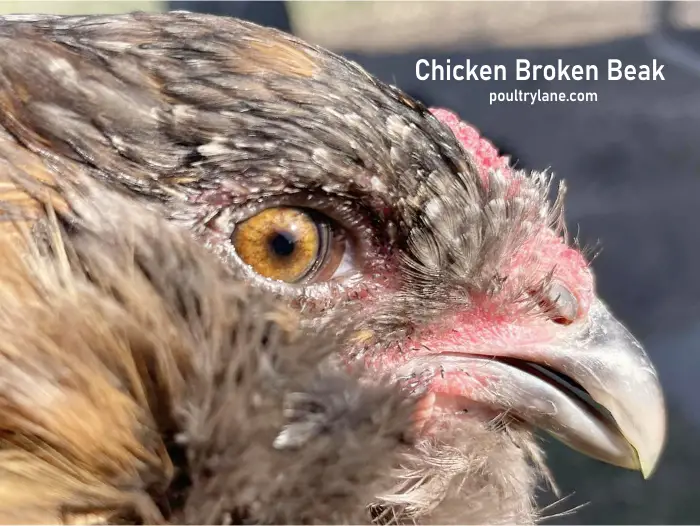Chicken beaks can break and even fall off in some cases. They use their beaks to perform various tasks, including eating, grasping, communicating, and drinking. Therefore, a broken beak can cause severe stress to a chicken.
Chickens can easily injure their beaks due to their curiosity and pecking nature. The injury may be a simple chip or a fracture on the lower or upper beak. On the same note, the damage may be severe, causing the beak to partially or entirely remove itself from its holding structure.
A severe injury will hinder the chicken from feeding, which can cause starvation or death. Therefore, knowing what to do when damage or breakage occurs is important.
Table of Contents
What can break a chicken’s beak?
As you know, chickens use their beaks to perform many tasks, including attacking other chickens or predators. Therefore, there is always a high probability of chickens breaking their beaks. Mostly, chickens experience minor break injuries, but sometimes, they can be fatal.
Causes of broken chicken beaks include:
- Fighting predators.
- Collusion with hard objects.
- Fights with other chickens.
- Getting their beaks stuck between things like gaps in their chicken coops.
- Digging and pecking on tough surfaces.
Among all the causes, fighting with other chickens remains the most common cause of chicken beak injuries. You can prevent this by providing the chicken with adequate feeds and water to avoid fighting over these resources. Also, avoid overcrowding chickens in one coop and give them enough “personal” space.

How to fix a broken or injured chicken beak
Before deciding on the best way to fix your chicken’s broken beak, you must examine it and determine if the injury is minor or severe.
A tiny crack on a chicken’s beak will naturally heal, repair itself and grow. However, a severely injured beak with a partial or serious misalignment may need splinting or patching with a composite cast until it grows back.
If there is severe damage with constant leading, you can contact a veterinary officer to assist you with proper fix ideas.
If the injury is manageable, start by stopping the bleeding from the wounds, cleaning them, and treating them. You can use medicated powders that help in blood clotting and preventing bleeding.
For a broken beak with a fallen chip, you need to fix it back using the following procedure:
- Clean the affected area and let it dry completely
- Cut a patch from an empty teabag. The patch should be slightly larger than the broken part.
- Place adequate superglue on the patch you’ve cut out.
- Place the broken beak piece into the affected area, ensuring it fits correctly, then place the moist patch over it.
- Wait for the glue to dry, then add another thin layer of glue over it using a cotton swab and let it dry.
If the damage deformed the shape of the beak, you could trim them back to shape using nail clippers. If there are rough edges, smoothen them using a nail file before letting them go. Always keep examining the chicken until the beak has grown back completely.
Broken beak with exposed tissue
Your chicken’s beak will be severely injured at times, causing its tissue to be exposed. When that’s the case, you should take it away from the rest of the flock. Due to the blood, other chickens will peck the injured chicken resulting in more pain and injury.
Next, clean the reddish part using Vetericyn spray, Betadine, or Hydrogen Peroxide to ensure the red tissue is no longer visible. Apply the wound cleaner weekly for the next few days until the wound heals.
If the injury severely breaks the chicken’s beak when it attaches to the skull, it requires specialized treatment using anti-inflammatories or antibiotics. When this happens, focus on preventing the bleeding until the veterinarian examines the chicken to prescribe the proper medication and treatment procedure.
How to feed a chicken with a broken beak
Chicken with injured or broken beaks experiences difficulty in their feeding process. You should provide them with adequate water and regular feeds. Do not offer them feeds they do not normally eat, as it may cause digestive problems.
To help them eat, mix their feed with water to form a wet mash. Always clean the leftovers to avoid mold growing on the feed, and replace it with a well-mixed mash.
Do chicken beaks grow back?
Cracked or injured chicken beaks usually grow back and heal entirely with proper care and treatment. At this point, snacks like kale for chickens will help in hydration, and calcium supplements will help in quick recovery.
Isolate it from the rest of the flock to avoid more injuries that may hinder its natural recovery. Water can be provided using a straw to keep the chicken hydrated and healthy.
Lastly, prevention is better than cure. Always be observant of your chickens to prevent injuring themselves or their beaks. You should also ensure that you have contacts of nearby veterinarians who you can call in case of emergencies.
Understanding chicken beaks
The chickens’ beaks comprise a tough and insoluble protein called keratin. This rigid layer is also in hooves, horns, and human fingernails. As you’ve already observed, the beak has two parts:
- Maxillary rostrum: The upper part of the beak
- Mandibular rostrum: The bottom part of the beak
The maxillary rostrum is typically longer than the bottom part of the beak. The two parts are connected to the chicken skull, attaching and receiving blood supply. At the meeting point of the beak and skull, numerous nerves and blood vessels make it super sensitive to pain and can lead to severe bleeding if injured.
The beak’s outer tip has no nerves or blood vessels, making it safe to trim without causing any bleeding or pain. The beaks, just like your fingernails, keep growing, and therefore they require proper maintenance.